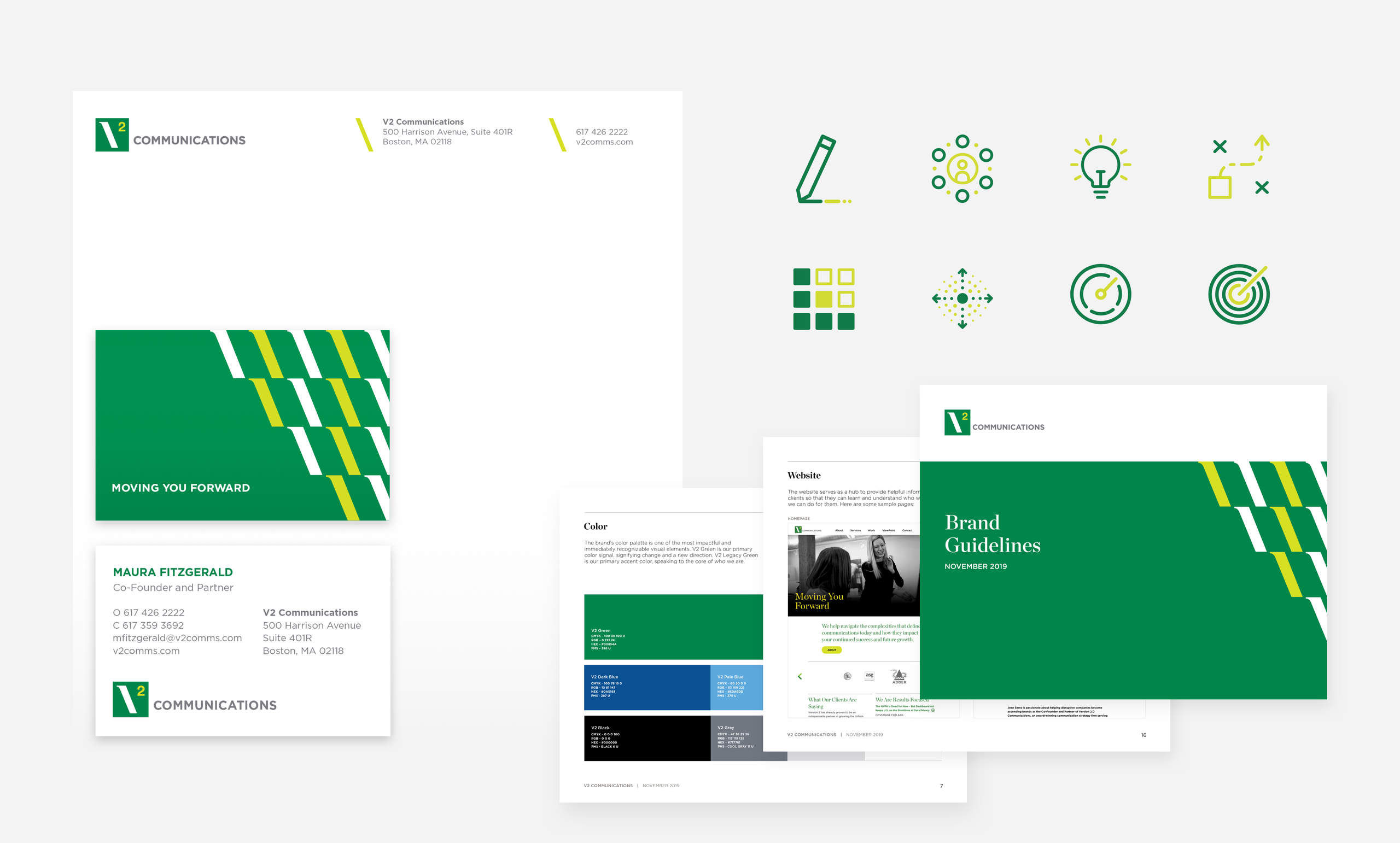Demystifying the Branding Process
First appeared on V2’s blog, reposted with permission.
An Interview with V2’s Founding Partner, Maura FitzGerald, and IOP’s Creative Director John Connolly on V2’s New Brand Design
MF: As you’ve hopefully seen by now, last week we unveiled our agency’s new name and design as V2 Communications. Achieving this rebrand was a long but worthwhile journey for attaining a renewed sense of self and a distinguished, captivating brand image that we believe accurately reflects the agency V2 has grown to be over the years.
To kick off this process, we enlisted the help of John Connolly at Ideas On Purpose, the creative guru who helped us build our original logo and brand image back in 2006. We recently sat down with him again to recap the journey and demystify the process for other companies considering—and perhaps feeling daunted by the idea of—a rebrand.
MF: How do companies know when it’s time to revisit their brand? Are there occasions when you advise clients against doing this?
JC: Typically, rebranding occurs during an inflection point of the business. This could be the result of a new strategy, name change or evolution, growth plan, a merger or acquisition or a redefinition of the brand offering in the marketplace. Other times, nothing has changed, and it’s simply been too long. You’ve outgrown your brand and need to refresh to become more current in the marketplace. Regardless, a rebrand is not something you can do often as it requires a lot of effort and touches every aspect of your business communications, marketing and physical space.
Often, companies opt for a partial rebrand versus a full rebrand as it’s easier to accomplish. The decision depends on how they want to communicate this initiative to their audiences. A refresh to the brand will make them look more current but a full rebrand will signal a bigger change.
Below, logo before and after the rebranding.

Can you describe the process IOP takes a client through during a rebrand? What can a client expect to invest in terms of time and money?
IOP begins with research and analysis to learn as much as possible about a client. The first step in this is establishing a working group from the client side who will be responsible for guiding our requests and act as a liaison to their stakeholders. For larger companies, this can be a group consisting of internal and external communications leaders, HR, IT, digital marketing, etc.
We then start on an audit of all communications. What is the tone of the language, design and brand image being communicated externally? Simultaneously, we asses a peer set of companies to understand the marketplace. These findings inform us in our next step of interviewing stakeholders, internal staff and external customers and partners.
This research also sets the stage for the brand platform, which outlines the rebrand strategy and sets the key messages, the brand pillars and the brand attributes going forward. In essence, it’s the brand narrative. We use this as a basis to explore creative directions for the logo and brand visual language across all touchpoints (business cards, office communication templates, website, signage, etc.).
The last step—and it’s an important one—is the brand activation phase, where implementation and production of all marketing and communications materials come to life.
Cost for brand strategy and design development is relative to a scaling process of what is needed in each phase—from how extensive the research is to the number of design presentations. Additionally, there are implementation costs, which include rolling out new marketing materials and website, office communication templates and branding your physical space with signage. The time frame can run from six to nine months, but that can be longer depending on content generation, approval processes and complexity of deliverables.
What are the important things for you and your team to know and understand in order to best counsel clients through this process?
First and foremost, why do they want to rebrand? What is the inflection point they are at with the business, and what’s their vision of where the company is going?
Understanding the peer set and brand POV in the industry, along with current client and partner perceptions, is also key to help us shape their brand going forward.

You advised us when we were just starting out as an agency, designing our original brand identity. How do you think we’ve evolved since then? How is this reflected in the new brand?
Looking back at IOP’s creative brief from 2006, there are notable differences in how we initially set out to brand V2. In 2006, Version 2.0 Communications was a start-up that wanted to be perceived as a tech-savvy agency. We originally conceived the brand built around your 3-point approach: strategy, partnership and results. We created a logo of 3 concentric circles, giving the identity strategic meaning and motion. The color palette was brighter and whiter in line with tech startups of the 2000s. The icons, brand elements and illustrations were more youthful. The brand attributes grounding the identity design were: “intelligent, assertive, creative, flexible, with a sense of humor”.
Fast forward to 2020, the agency has matured. Your reputation among your clients and peers is solid, with the shorthand name V2 becoming a commonplace among the clients and partners. With that, it was time to pivot to reflect what your stakeholders had come to accept as the sophisticated, smart agency of today. V2’s newly refreshed brand captures movement and momentum, communicates a sophisticated organization that is grounded, sharp and perceptive, and continue to deliver winning results.